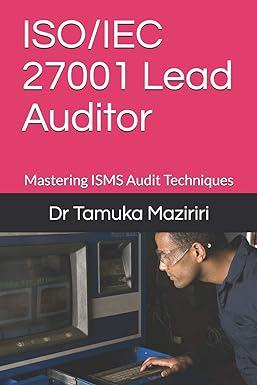Mastery Problem: Variable Costing for Management Analysis
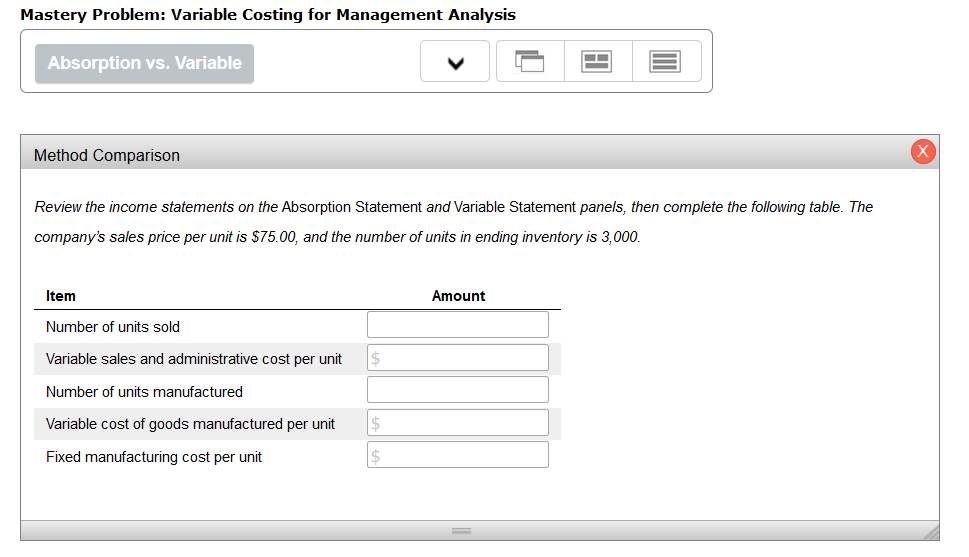
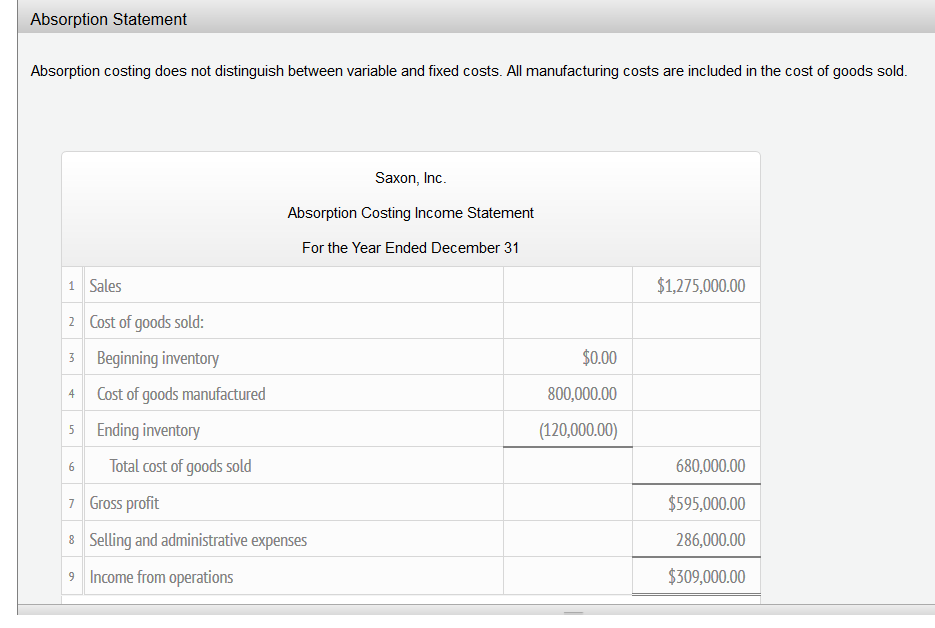
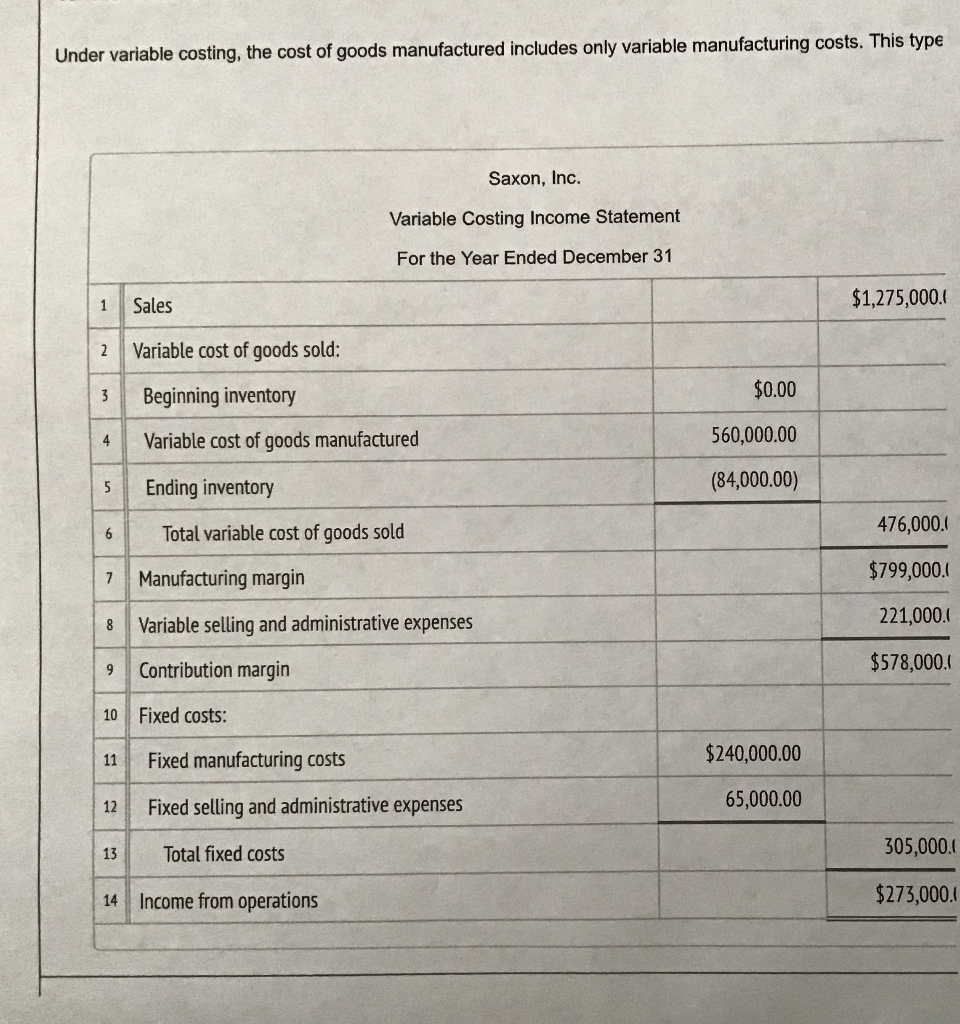
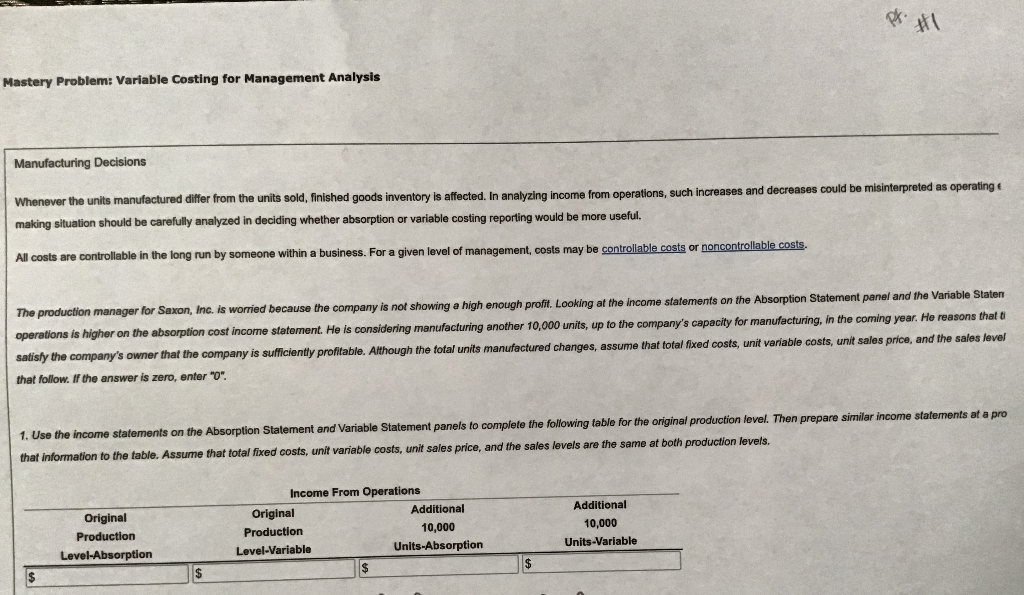
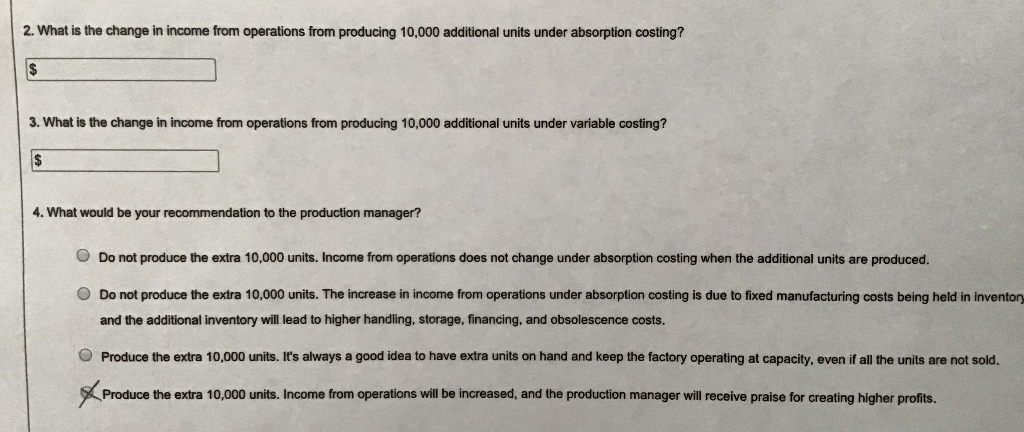
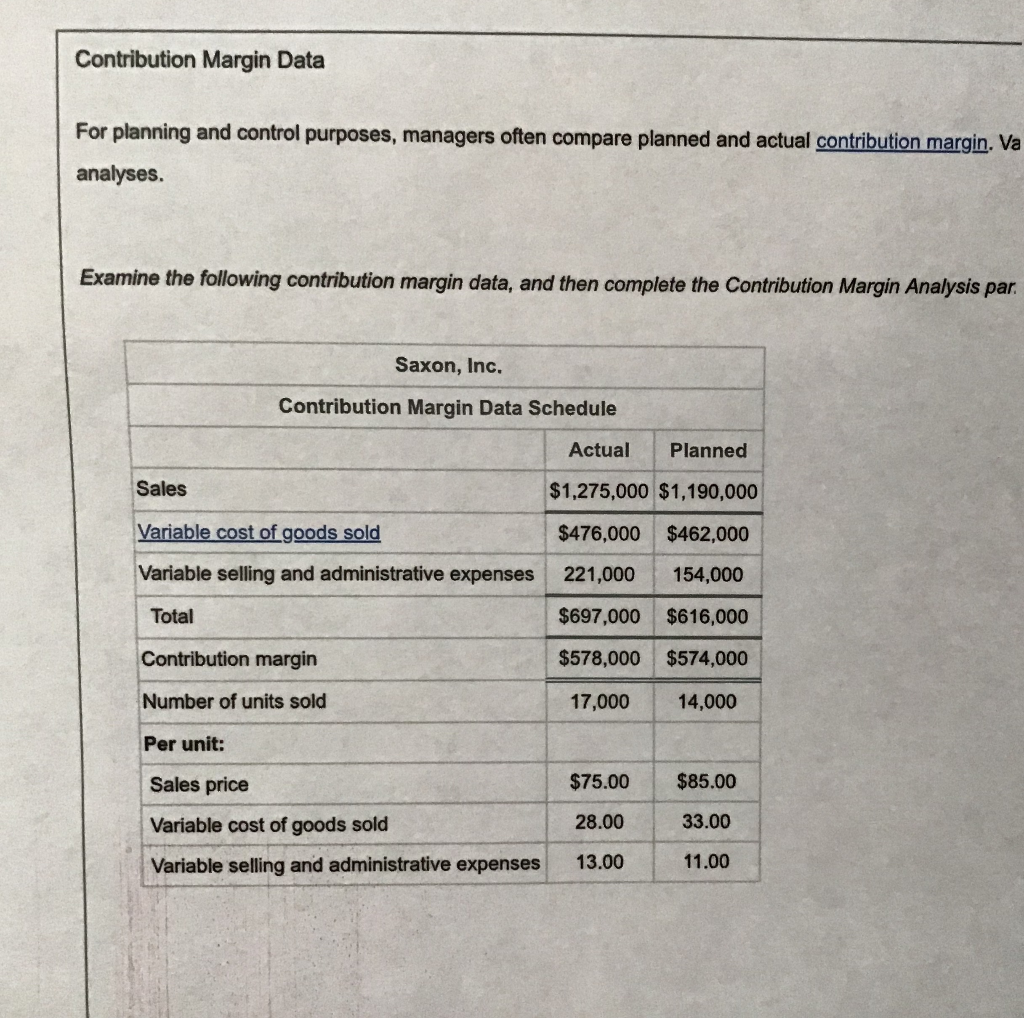
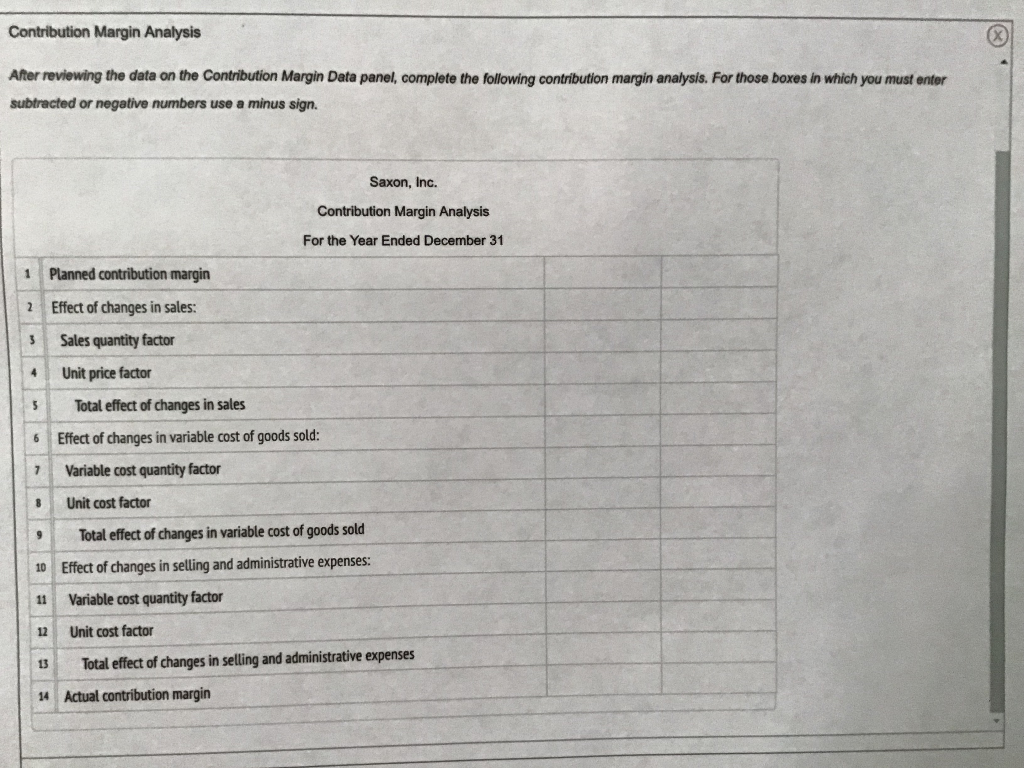
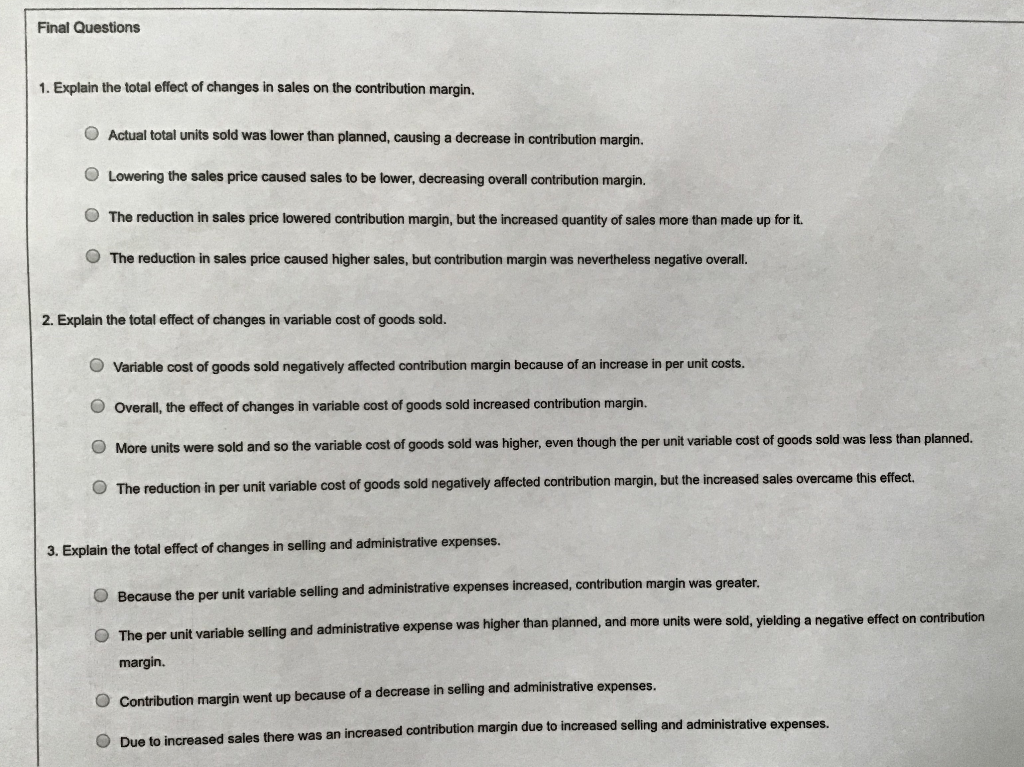
Mastery Problem: Variable Costing for Management Analysis Absorption vs. Variable Method Comparison Review the income statements on the Absorption Statement and Variable Statement panels, then complete the following table. The company's sales price per unit is $75.00, and the number of units in ending inventory is 3,000. Item Amount Number of units sold Variable sales and administrative cost per unit $ Number of units manufactured Variable cost of goods manufactured per unit Fixed manufacturing cost per unit Under variable costing, the cost of goods manufactured includes only variable manufacturing costs. This type Saxon, Inc. Variable Costing Income Statement For the Year Ended December 31 Sales $1,275,000.1 Variable cost of goods sold: Beginning inventory $0.00 4 Variable cost of goods manufactured 560,000.00 (84,000.00) Ending inventory Total variable cost of goods sold 476,000.1 Manufacturing margin $799,000.1 Variable selling and administrative expenses 221,000.1 9 Contribution margin $578,000.1 10 Fixed costs: Fixed manufacturing costs $240,000.00 12 Fixed selling and administrative expenses 65,000.00 13 Total fixed costs 305,000. 14 Income from operations $273,000. Mastery Problem: Variable Costing for Management Analysis Manufacturing Decisions Whenever the units manufactured differ from the units sold, finished goods inventory is affected. In analyzing income from operations, such increases and decreases could be misinterpreted as operating making situation should be carefully analyzed in deciding whether absorption or variable costing reporting would be more useful. All costs are controllable in the long run by someone within a business. For a given level of management, costs may be controllable costs or noncontrollable costs. The production manager for Saxon, Inc. is worried because the company is not showing a high enough profit. Looking at the income statements on the Absorption Statement panel and the Variable Staten operations is higher on the absorption cost income statement. He is considering manufacturing another 10,000 units, up to the company's capacity for manufacturing, in the coming year. He reasons that satisfy the company's owner that the company is sufficiently profitable. Although the total units manufactured changes, assume that total fixed costs, unit variable costs, unit sales price, and the sales level that follow. If the answer is zero, entero". 1. Use the income statements on the Absorption Statement and Variable Statement panels to complete the following table for the original production level. Then prepare similar income statements at a pro that information to the table. Assume that total fixed costs, unit variable costs, unit sales price, and the sales levels are the same at both production levels. Original Production Level-Absorption Income From Operations Original Additional Production 10,000 Level-Variable Units-Absorption Additional 10,000 Units-Variable 2. What is the change in income from operations from producing 10,000 additional units under absorption costing? 3. What is the change in income from operations from producing 10,000 additional units under variable costing? 4. What would be your recommendation to the production manager? Do not produce the extra 10,000 units. Income from operations does not change under absorption costing when the additional units are produced. Do not produce the extra 10,000 units. The increase in income from operations under absorption costing is due to fixed manufacturing costs being held in inventor and the additional inventory will lead to higher handling, storage, financing, and obsolescence costs. O Produce the extra 10,000 units. It's always a good idea to have extra units on hand and keep the factory operating at capacity, even if all the units are not sold. Produce the extra 10,000 units. Income from operations will be increased, and the production manager will receive praise for creating higher profits. Contribution Margin Data For planning and control purposes, managers often compare planned and actual contribution margin, Va analyses. Examine the following contribution margin data, and then complete the Contribution Margin Analysis par. Saxon, Inc. Contribution Margin Data Schedule Actual Planned Sales Variable cost of goods sold $1,275,000 $1,190,000 $476,000 $462,000 221,000 154,000 Variable selling and administrative expenses Total $697,000 $616,000 $578,000 $574,000 Contribution margin Number of units sold 17,000 14,000 Per unit: Sales price $75.00 $85.00 28.00 33.00 Variable cost of goods sold Variable selling and administrative expenses 13.00 11.00 Contribution Margin Analysis After reviewing the data on the Contribution Margin Data panel, complete the following contribution margin analysis. For those boxes in which you must enter subtracted or negative numbers use a minus sign. Saxon, Inc. Contribution Margin Analysis For the Year Ended December 31 1 2 3 Planned contribution margin Effect of changes in sales: Sales quantity factor Unit price factor Total effect of changes in sales Effect of changes in variable cost of goods sold: 6 Variable cost quantity factor Unit cost factor Total effect of changes in variable cost of goods sold 10 Effect of changes in selling and administrative expenses: 12 Variable cost quantity factor Unit cost factor Total effect of changes in selling and administrative expenses 13 14 Actual contribution margin Final Questions 1. Explain the total effect of changes in sales on the contribution margin. Actual total units sold was lower than planned, causing a decrease in contribution margin. Lowering the sales price caused sales to be lower, decreasing overall contribution margin. The reduction in sales price lowered contribution margin, but the increased quantity of sales more than made up for it. The reduction in sales price caused higher sales, but contribution margin was nevertheless negative overall. 2. Explain the total effect of changes in variable cost of goods sold. O Variable cost of goods sold negatively affected contribution margin because of an increase in per unit costs. Overall, the effect of changes in variable cost of goods sold increased contribution margin. More units were sold and so the variable cost of goods sold was higher, even though the per unit variable cost of goods sold was less than planned. The reduction in per unit variable cost of goods sold negatively affected contribution margin, but the increased sales overcame this effect. 3. Explain the total effect of changes in selling and administrative expenses. O Because the per unit variable selling and administrative expenses increased, contribution margin was greater. The per unit variable selling and administrative expense was higher than planned, and more units were sold, yielding a negative effect on contribution margin. O Contribution margin went up because of a decrease in selling and administrative expenses. O Due to increased sales there was an increased contribution margin due to increased selling and administrative expenses. Mastery Problem: Variable Costing for Management Analysis Absorption vs. Variable Method Comparison Review the income statements on the Absorption Statement and Variable Statement panels, then complete the following table. The company's sales price per unit is $75.00, and the number of units in ending inventory is 3,000. Item Amount Number of units sold Variable sales and administrative cost per unit $ Number of units manufactured Variable cost of goods manufactured per unit Fixed manufacturing cost per unit Under variable costing, the cost of goods manufactured includes only variable manufacturing costs. This type Saxon, Inc. Variable Costing Income Statement For the Year Ended December 31 Sales $1,275,000.1 Variable cost of goods sold: Beginning inventory $0.00 4 Variable cost of goods manufactured 560,000.00 (84,000.00) Ending inventory Total variable cost of goods sold 476,000.1 Manufacturing margin $799,000.1 Variable selling and administrative expenses 221,000.1 9 Contribution margin $578,000.1 10 Fixed costs: Fixed manufacturing costs $240,000.00 12 Fixed selling and administrative expenses 65,000.00 13 Total fixed costs 305,000. 14 Income from operations $273,000. Mastery Problem: Variable Costing for Management Analysis Manufacturing Decisions Whenever the units manufactured differ from the units sold, finished goods inventory is affected. In analyzing income from operations, such increases and decreases could be misinterpreted as operating making situation should be carefully analyzed in deciding whether absorption or variable costing reporting would be more useful. All costs are controllable in the long run by someone within a business. For a given level of management, costs may be controllable costs or noncontrollable costs. The production manager for Saxon, Inc. is worried because the company is not showing a high enough profit. Looking at the income statements on the Absorption Statement panel and the Variable Staten operations is higher on the absorption cost income statement. He is considering manufacturing another 10,000 units, up to the company's capacity for manufacturing, in the coming year. He reasons that satisfy the company's owner that the company is sufficiently profitable. Although the total units manufactured changes, assume that total fixed costs, unit variable costs, unit sales price, and the sales level that follow. If the answer is zero, entero". 1. Use the income statements on the Absorption Statement and Variable Statement panels to complete the following table for the original production level. Then prepare similar income statements at a pro that information to the table. Assume that total fixed costs, unit variable costs, unit sales price, and the sales levels are the same at both production levels. Original Production Level-Absorption Income From Operations Original Additional Production 10,000 Level-Variable Units-Absorption Additional 10,000 Units-Variable 2. What is the change in income from operations from producing 10,000 additional units under absorption costing? 3. What is the change in income from operations from producing 10,000 additional units under variable costing? 4. What would be your recommendation to the production manager? Do not produce the extra 10,000 units. Income from operations does not change under absorption costing when the additional units are produced. Do not produce the extra 10,000 units. The increase in income from operations under absorption costing is due to fixed manufacturing costs being held in inventor and the additional inventory will lead to higher handling, storage, financing, and obsolescence costs. O Produce the extra 10,000 units. It's always a good idea to have extra units on hand and keep the factory operating at capacity, even if all the units are not sold. Produce the extra 10,000 units. Income from operations will be increased, and the production manager will receive praise for creating higher profits. Contribution Margin Data For planning and control purposes, managers often compare planned and actual contribution margin, Va analyses. Examine the following contribution margin data, and then complete the Contribution Margin Analysis par. Saxon, Inc. Contribution Margin Data Schedule Actual Planned Sales Variable cost of goods sold $1,275,000 $1,190,000 $476,000 $462,000 221,000 154,000 Variable selling and administrative expenses Total $697,000 $616,000 $578,000 $574,000 Contribution margin Number of units sold 17,000 14,000 Per unit: Sales price $75.00 $85.00 28.00 33.00 Variable cost of goods sold Variable selling and administrative expenses 13.00 11.00 Contribution Margin Analysis After reviewing the data on the Contribution Margin Data panel, complete the following contribution margin analysis. For those boxes in which you must enter subtracted or negative numbers use a minus sign. Saxon, Inc. Contribution Margin Analysis For the Year Ended December 31 1 2 3 Planned contribution margin Effect of changes in sales: Sales quantity factor Unit price factor Total effect of changes in sales Effect of changes in variable cost of goods sold: 6 Variable cost quantity factor Unit cost factor Total effect of changes in variable cost of goods sold 10 Effect of changes in selling and administrative expenses: 12 Variable cost quantity factor Unit cost factor Total effect of changes in selling and administrative expenses 13 14 Actual contribution margin Final Questions 1. Explain the total effect of changes in sales on the contribution margin. Actual total units sold was lower than planned, causing a decrease in contribution margin. Lowering the sales price caused sales to be lower, decreasing overall contribution margin. The reduction in sales price lowered contribution margin, but the increased quantity of sales more than made up for it. The reduction in sales price caused higher sales, but contribution margin was nevertheless negative overall. 2. Explain the total effect of changes in variable cost of goods sold. O Variable cost of goods sold negatively affected contribution margin because of an increase in per unit costs. Overall, the effect of changes in variable cost of goods sold increased contribution margin. More units were sold and so the variable cost of goods sold was higher, even though the per unit variable cost of goods sold was less than planned. The reduction in per unit variable cost of goods sold negatively affected contribution margin, but the increased sales overcame this effect. 3. Explain the total effect of changes in selling and administrative expenses. O Because the per unit variable selling and administrative expenses increased, contribution margin was greater. The per unit variable selling and administrative expense was higher than planned, and more units were sold, yielding a negative effect on contribution margin. O Contribution margin went up because of a decrease in selling and administrative expenses. O Due to increased sales there was an increased contribution margin due to increased selling and administrative expenses














